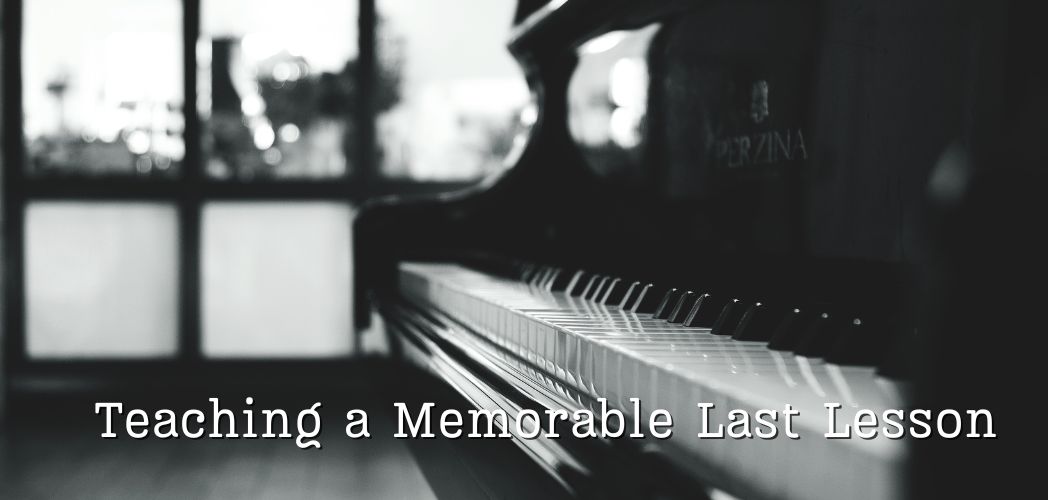Students stop piano lessons for all kinds of reasons, sometimes they are heading to the next step in their musical career, but often students quit for more mundane reasons. It’s sad to realise, but these students’ risk never playing a piano again.
Unfortunately, the moment a student decides to stop lessons, playing piano becomes something they used to do. Turning up to the last lesson becomes merely a formality. After all, the fee for lessons has been paid, and they will likely still attend, but current repertoire, scales challenges, and goals for the year become irrelevant.
In my younger days, I would teach the last lesson as a continuation of what came before. I’m reasonably confident this resulted in my students thinking, “When is this going to end?!” Last lessons are important, and I was not content to let it be a mediocre experience. I decided to find a different path to send students on their way with a sense of pride in their achievements and a toolkit of skills that will help them feel confident to play any piano they might come across.
Showcasing Student Progress
Piano Skills Review
I like to start with a chat about how far the student has come in their time with me. It’s not often that we slow down and chat during a lesson, but this is a time to talk as friends. The teacher-student dynamic is ending anyway, so relaxing these barriers helps the student see how far they have grown.
Then I bring out materials that every beginner student has used, like the ladybug for hand-shape and oversized flash cards for note identification. During our chat we can stop and think about how much they have progressed past needing these tools (and how they can now reach the pedal!).
We remember that time when the student struggled to play each finger one at a time. We look back on old method books and remember how proud they were to be able to play “Firefly” or other beginner pieces. Then we compare this to their current music and marvel at the difference.
Musical Knowledge Review
Often intermediate or advanced students forget how learning to read music has been like learning a foreign language of signs, symbols, and phrases. I like to drive home the point of just how much they have absorbed over the time. It doesn’t matter how far they have come; the point is to show they have progressed.
To do this, I bring out a pre-prepared stack of flash cards that I am confident the student will know. We have a super quick run through to prove they do, in fact, know all the musical symbols on the cards, and then we step back and look at the stack, possibly fanning them out on the table to give a good visual of just how much the student knows.
Preparation for Musical Confidence
Walking Bass Boogie / Chords
Another important aspect for me is to equip my students with the courage to approach a piano at any time and feel comfortable noodling around on it (I wish I had been given this gift as a teenager). A final lesson can be a great time to learn a simple walking bass line or a chord progression that will “wow” their friends.
A great activity is to teach a basic minor blues scale (C, Eb, F, Gb, G, Bb, C) using only thumb and third finger in the RH. We swing this up and up and up the piano and then down and down and down again until the spacing feels comfortable. Throw in a C minor chord in the LH and suddenly things sound more sophisticated. We try out little groupings of notes – repeated triplets, ascending and descending runs, and every so often refresh that LH chord.
More advanced students can move to a G minor blues scale and copy the pattern; other students like the freedom to try out pedalling and messing around with blending and blurring the sounds. The best part is that there are no wrong notes with jazz improv. Unexpected notes just add colour!
For more in-depth ideas about improvising scales, have a look at this article from Eric Baumgartner http://thepianoteacher.com.au/articles/beginning-improvisation-a-brief-look-at-two-magical-scales/
Supported Improvisation
Finishing with a duet improvisation might just be one of the nicest ways to end the lesson. There are only two rules: Use an agreed group of notes and keep in time with the beat! This allows me to play chords and a supporting structure while the students move around the piano as they desire. Playing together always brings out some laughs and I love how students get lost in the moment. This is an awesome time to video the student as together you create music that sounds rich and layered. These videos are a winner with parents too!
Best Ever Lesson at Last?!
I’ve had some last lessons that have been so much fun that I’ve wondered if the student will sign up again! I love seeing students realise just how far they have come, how much they know about music, and how fun it can be to mess around on the keys.
I believe it’s important in a last lesson to have that combination of highlighting the student’s accomplishments, plus time being creative on the keys. In my experience, this sets students up to feel confident in their musical abilities and leaves a lasting impression of the joy of making music.
